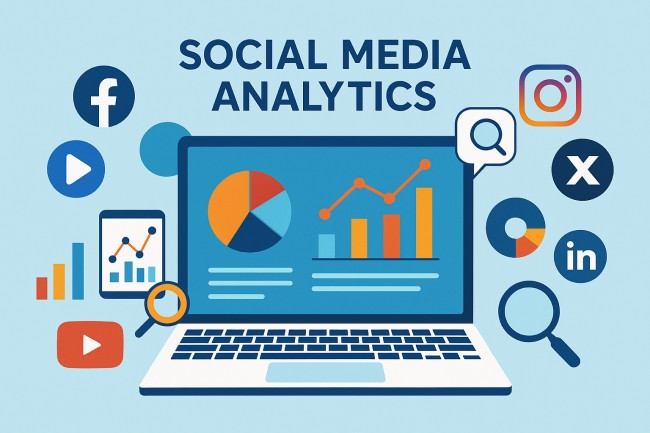What Is Social Media Analytics? A Technical and Strategic Examination of Data-Driven Social Media Intelligence

Social media analytics is how businesses gather, measure, and understand data from social media sites so they can make better choices. People are talking all the time on places like Facebook, YouTube, Instagram, X, LinkedIn, and Reddit. Companies use analytics to make sense of all that online chatter.
Instead of just looking at likes or follower counts, social media analytics today goes deeper. It looks at how people act, what’s being talked about, who the audience is, what people think of a brand, and how well the content does. Businesses use tools to make campaigns better, fix customer service problems, protect their image, and see whether what they do actually works for the business.
Technical foundations and scope of social media analytics
At the core, social media analytics is all about constantly monitoring, measuring, and interpreting important factors like:
- User behavior
- Audience demographics + psychographics
- Engagement and interaction trends
- Brand awareness and share of voice
- Sentiment and emotional tone
- Competitive activity and industry benchmarks
This entire process often starts with social media monitoring, which captures raw data before it gets cleaned and analyzed.
The process pulls data from tons of sources, normalizes it, and then uses analytical techniques to extract insights. Modern tools rely on technology such as:
- Natural language processing (NLP)
- Machine learning classification models
- Entity recognition
- Topic modeling
- Clustering algorithms
- Predictive analytics
The main goal? Pretty simple: turn messy online conversations into intelligence that supports better decisions, improved customer connections, and stronger social media performance.
Key capabilities of effective social media analytics
While the analytics journey usually starts with setting goals, picking keywords, choosing dates, and selecting sources, the real value shows up in the advanced features that platforms bring.
1. Natural Language Processing (NLP) and Machine Learning
Social media content is unstructured and full of slang, sarcasm, and context that isn’t always straightforward. NLP + ML help:
- Identify people, brands, and products
- Understand relationships
- Detect tone or emotion
- Auto-classify themes and categories
Without these technologies, it would be almost impossible to make sense of the chaos.
2. Segmentation and Audience Categorization
Segmentation helps group users based on:
- Age
- Gender
- Location
- Interests
- Parental or marital status
- Lifestyle characteristics
It also identifies micro-influencers, brand fans, critics, and niche communities. With the help of social media monitoring tools, segmentation becomes more precise, enabling personalized messaging.
3. Behavioral Analysis
Behavior analysis helps figure out why people act the way they do online. Users might be:
- Active
- Recommenders
- Silent observers
- Prospects
- Detractors
This lets businesses tune their customer service, messaging, and product updates accordingly.
4. Sentiment Analysis
Sentiment analysis examines emotional tone—positive, negative, neutral, or mixed. It highlights:
- Praise
- Complaints
- Confusion
- Pain points
- Satisfaction or dissatisfaction trends
It’s basically a real-time health check of brand reputation.
5. Share of Voice (SOV)
Share of voice measures how much people talk about your brand compared to your competitors. It helps brands:
- Understand their visibility
- Spot risks
- See competitive pressure
- Track discussions around launches or campaigns
SOV is honestly one of the clearest indicators of industry influence.
6. Clustering and Topic Modeling
Clustering groups similar words and phrases, helping uncover:
- Hidden or new conversations
- Emerging trends
- Unexpected customer issues
- New product use cases
Brands often discover things they never planned for—like alternative uses for baking soda—thanks to clustering insights.
7. Dashboards and Visualization
Dashboards convert complex data into visual formats like:
- Charts
- Graphs
- Heatmaps
- Tables
- Trend lines
This makes it easier for decision-makers to understand what’s going on without being analytics experts.
How to track social media performance with analytics tools
1. Gather Social Media Metrics and Data
Make sure your tool collects data from social platforms, CRM, website analytics, and other systems. More data = more accurate insights.
2. Set Benchmarks
Benchmarks help compare performance with:
- Past results
- Competitors
- Industry averages
Without context, numbers don’t mean much.
3. Generate Analytics Reports
Strong tools offer:
- Automated scheduled reports
- Campaign-specific reports
- Real-time dashboards
- Flexible templates
Reporting is essential for spotting patterns and sharing insights.
4. Search for Trends and Behaviors
Reports help businesses:
- Identify trends
- Track user preferences
- Understand customer journeys
- Spot bottlenecks in conversions
These insights guide content and strategic decisions.
5. Take Action
Analytics should trigger action like:
- Website improvements
- Better social support
- Adjusted messaging
- Faster responses
- Automated workflows
Data only matters when it drives results.
6. Share Insights and Repeat
Analytics is not a one-time thing. Regular reporting ensures:
- Continuous monitoring
- Early trend identification
- Organization-wide alignment
- Real-time adaptability
Repeating the cycle makes insights more accurate over time.
Measuring the ROI of social media marketing through analytics
One of the toughest jobs in marketing is connecting social media activity to real revenue. Analytics finally gives businesses a way to understand this connection.
1. Track Conversion Rates
Conversions include:
- Purchases
- Sign-ups
- Demo requests
- Form fills
- Resource downloads
Knowing which channels convert best helps optimize budgets and strategies.
2. Analyze Customer Lifetime Value (CLV)
CLV shows how much revenue a customer brings over their entire relationship with a brand. It helps:
- Evaluate social-acquired customer quality
- Identify high-value groups
- Boost retention
- Reduce churn
High CLV usually means stronger engagement and loyalty.
Conclusion
Social media analytics is no longer optional—it’s essential. With tools like NLP and machine learning, companies can finally figure out what all the online chatter means.
If you keep an eye on the right numbers, set some goals, use reports that run themselves, and always try to get better, you can do better work, make your customers happier, keep up with the competition, and really see how much you’re getting back from social media.



